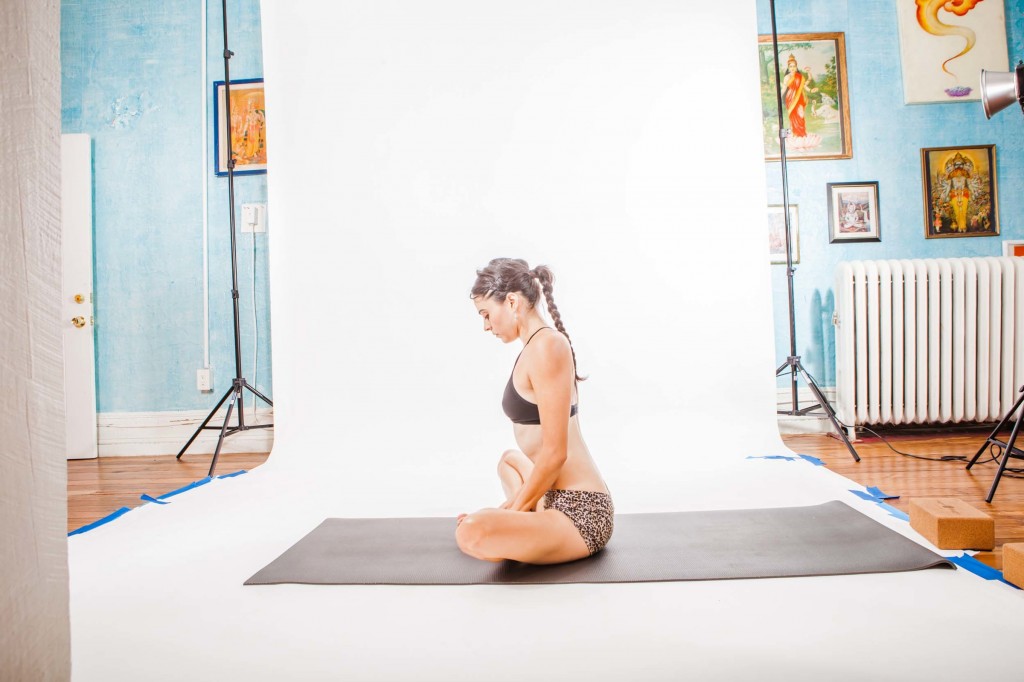
Baddhakonasana, Bound Angle Pose, is an important hip opening seated posture that is found in the primary series. In this blog post I provide instruction for the upright phase and the two forward bending phases (extending and then rounding of your spine) of this asana.

(Joe Longo Photography)
For the upright phase, having established a stable, neutral pelvic position in Dandasana (Staff Posture), maintain this foundation and bring your feet back as close to your pubic bone as possible. Join the soles of your feet together evenly, press heels and the mounds of the toes together evenly, especially attempt to join the ball of the big toes. Clasp your feet with your fingers and pull on your feet to broaden your chest and center your torso directly over your upright pelvis.
Open the thighs outward, imagine that the thigh bones lengthen and extend away from you in a line from the hip to the knee. Soften and release the inner thighs, and endeavor to ground the thighs downward towards the earth. Keep the sacrum (back of the pelvis) sucked forward into the body, sit directly on the sitting bones, feel the pelvis and thighs as supremely weighted and heavy. Lift up the spine and suck the navel up and back strongly (Uddhyana Bandha), Allow this lift to create more length between the pubic bone and navel and the navel and the diaphragm. By creating length along the front of the lower torso, feel the lumbar (lower) spine irresistibly drawn forward into the body, this will help you to align your posture along the pillar of light (central axis). Float the core of the heart, expand the chest and widen the collarbones. Keep your head upright, chin level, and cast a steady gaze downwards. Sit here, enjoy your well founded stance for some time.
I recommend elevating your pelvis with a blanket or block if: 1) you cannot achieve and maintain a neutral pelvis i.e. it goes into a backward tilt) 2) despite your best efforts your lower back rounds 3) your thighs do not come down to the ground and thus your knees remain higher than your pelvis. Also if any of the above 3 conditions applies to you I recommend that you focus your work in this upright position more than working with the next phases of bending forward and bringing your torso towards the ground.

(Joe Longo Photography)
Now the forward bending phase. Strategize your set up for the dynamic gesture of bending forward in this position by opening the soles of the feet to the sky. To open the feet upwards place your fingers under your feet and your thumbs across the mounds of the toes.
-Decisively ground your pelvis and thighs, lift up the spine, open the chest and look up as though you were about to do a back bending drop back—your body is now poised, in a state of readiness—then with a single movement, extend up and out through the spine come forward maintaining the lift and extension of your navel.

(Joe Longo Photography)
Reach through your spine and endeavor to touch your navel to feet before your forehead or chest comes to the ground. This action of elongating your spine as you come forward will ensure that your hips will receive the most benefit from your efforts. If you allow your torso to shorten and your back to round too easily, you will fail to optimize the potential for creating flexibility in your hip joints. Ground your legs and bring your chest down, work to touch your forehead and then your chin to the floor.

(Joe Longo Photography)

(Joe Longo Photography)
Generally the rounded back variation of this posture is less challenging, and thus provides a entrance into the difficult forward bending aspect of this posture. The approach and thinking process are largely the same as already described for going forward in the previous section. Maintain your earth connected foundation by anchoring the pelvis and thighs. As you create your forward bending gesture bring your entire spine into flexion, round your back evenly and touch your forehead to your toes.
Stop your body, come to a still, resting place. Continue to press your thighs into the earth while staying with the ebb and flow rhythm of the breath. Steady your gaze downwards. Come up with a single move on an inhalation when you are ready.

(Joe Longo Photography)
The benefits of this posture include: promotes the same type of hip flexibility as Uttitha Trikonasana and Virabhadrasana II. The effort to remain upright as you sit helps build core strength. Baddha Konasana lends itself to longer stays, and thus this engaging seated posture gives you stamina, helps you learn to relish striking the Immovable Spot. Thus the wise yogi adopts Baddha Konasana, and its with practice he endeavors to become skilled in enjoying the silent void (shunya), achieving breath control (pranayama) and becoming absorbed in meditation (dhyana). Enjoy, OM!
Comments
No comments.